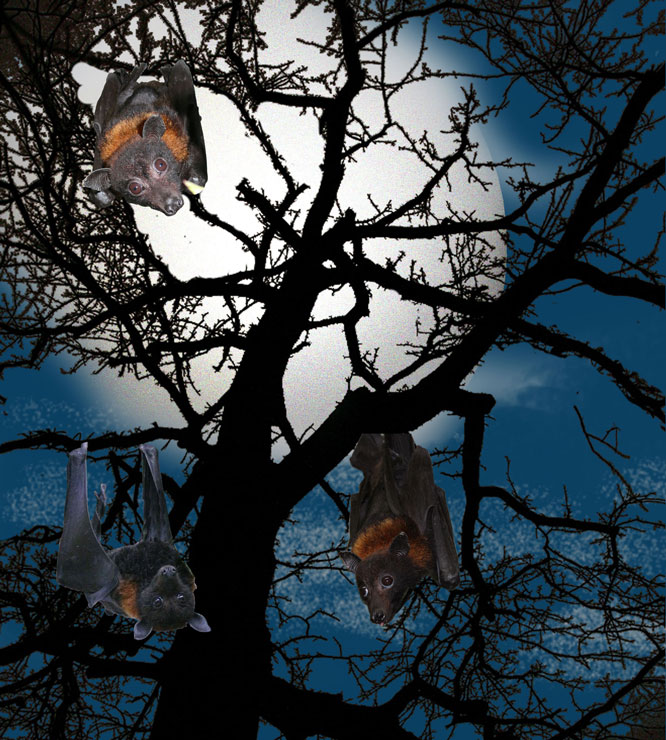How does evolution rewire an animal’s sensory system? In time for both National Bat Week and Halloween, new research in G3 investigates this question by comparing the genomes of bat species that “see” the world in different ways.
The black flying fox Pteropus alecto forages for fruit mainly by smell and sight. In contrast, the insectivorous Myotis davidii has vision adapted for dim light and hunts using the animal version of sonar—echolocation. Though it is not clear whether M. davidii evolved echolocation before or after the split from flying foxes, Hudson et al. reasoned that comparing the genomes of species with such divergent sensory preferences could shed light on the evolutionary mechanisms involved.
The researchers started by looking for evidence of functional decay in the visual system, examining bat orthologs of visual perception genes that are either inactivated or missing in the naked mole rat, a mammal with poor vision that lives most of its life in darkness. Of the 19 orthologs, five were inactivated by premature stop codons in echolocating M. davidii but not in the flying fox P. alecto. This evidence hints at loss of visual function associated with M. davidii’s poor day vision and small eyes.

The black flying fox Pteropus alecto uses smell and vision to forage and does not echolocate. Photo credit: Susanne Wilson/CSIRO
But there is more to sensory rewiring than loss of function. To identify potential signals of gain-of-function changes, Hudson et al. explored genome-wide patterns of codon usage bias between the two bat species. Codon usage bias refers to the nonrandom frequency of different synonymous codons. Extreme codon usage bias is thought to result partly from selection operating on the efficiency of translation.
The authors have previously found that extreme codon usage bias tends to occur in genes that are particularly characteristic of and important to the organism under study, such as genes involved in hair formation genes in mammals, mitochondrial function in birds, and chloroplast physiology in plants. They argue that extreme codon usage bias and selection on translation efficiency at the whole-pathway level may play an underappreciated role driving change during the evolution of new or enhanced functions (gain-of-function changes).
Of genes with extreme codon usage bias in the echolocator M. davidii, the functional class most overrepresented was retina development. Other statistically enriched functions included axon development and light and sound perception. In contrast, none of these classes were enriched for codon usage bias in P. alecto.
To learn whether this association between echolocation and codon bias in sensory genes holds up for other species, the authors performed a similar analysis for M. lucifugus (an echolocating bat) and P. vampyrus (non-echolocating). In this case, the authors did not find a statistically-significant enrichment of sensory perception genes among those with extreme codon bias. But when they examined the sensory genes that were enriched in the original analysis of M. davidii, all of these genes were more biased in echolocating M. lucifugus than in P. vampyrus.

Myotis davidii or David’s myotis echolocates and has small eyes adapted for low light. Photo credit: Susanne Wilson/CSIRO
This suggests that during the evolution of echolocation a set of genes involved in vision and hearing was under selection for new or enhanced functions—perhaps reflecting development of enhanced sensitivity to dim light and ultrasonic sound. Remarkably, genes involved in both hearing and vision also showed up in a 2013 study of convergent evolution in bats and dolphins, two groups that independently evolved the ability to echolocate. These latest results add to our developing understanding of sensory rewiring and paint a picture that combines both functional decay and novelty.
Hudson N.J., N. S. Hart, J. W. Wynne, Q. Gu, Z. Huang, G. Zhang, A. B. Ingham, L. Wang & A. Reverter (2014). Sensory Rewiring in an Echolocator: Genome-Wide Modification of Retinogenic and Auditory Genes in the Bat Myotis davidii, G3, 4 (10) 1825-1835. DOI: 10.1534/g3.114.011262 http://g3journal.org/content/4/10/1825.full































